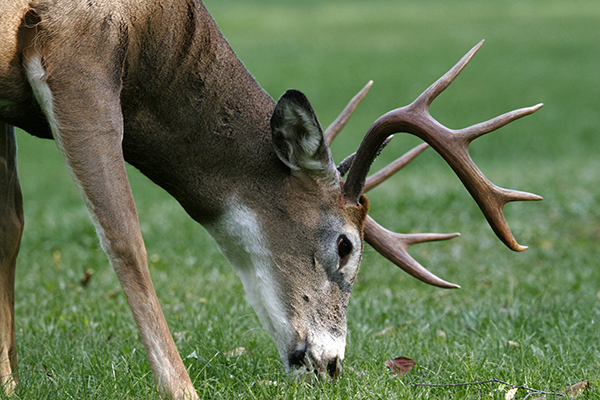Guide to Creating a Spring Food Plot for Deer Hunters

Guide to Creating a Spring Food Plot
Spring is the perfect time for deer hunters to start preparing food plots. The plans for deer season 2025 start now and a well-planned food plot not only improves hunting opportunities but also contributes to the overall health and nutrition of the local deer population. Creating a food plot takes preparation and effort, but with the right approach, you can establish a thriving plot that pays off during hunting season.
Clear the Area
The first step in establishing a food plot is selecting and clearing your area. Begin by choosing a site that’s close to established deer trails, water sources, or bedding areas. A small “honey hole” in a secluded spot can work just as well as a larger, more open plot—sometimes even better. I’ve had great success clearing an area in the timber; the deer love it!
Clearing the area involves removing existing vegetation. Mowing and brush cutting can work on eliminating grasses, shrubs, and smaller plants. For tighter spaces, consider using smaller equipment such as a weed eater, a brush blade, or a walk behind brushcutter. If trees are in the way, decide whether to keep them for a staging area and cover or cut them down to maximize sunlight. Often in the timber, sunlight can make or break a food plot, so don’t leave too many trees. Leaving felled trees along the perimeter can serve as a visual barrier, helping deer feel safe while feeding. It’s also a great place for bedding along the food plot.
Prepare the Soil
Once the area is clear, it’s time to prepare the soil. While some hunters do a “throw and grow” method with small seeds, this approach often yields mixed results. More times than not, it fails. For a more productive food plot, breaking the soil might be a better option.
It depends on your location, but tractors and plows and disc are ideal for larger plots. Tillers go slower, but leave a great seed bed. However, use carefully if you’re doing a food plot in the timber or around trees. Roots can potentially damage the tiller. If you don’t have a tractor, ATVs with plows or discs are great and offer more maneuverability in tighter spaces. One thing I have done to get my food plot is strapping a tiller to a 4-wheeler. This can take a lot of time to get a good seed bed, but sometimes you have to use what you have.
While breaking the soil may require extra effort, it creates a good seed bed and ensuring better seed-to-soil contact. Pay attention to obstacles like roots and stumps. Use a stump grinder to remove larger roots.
Test the Soil
Before planting, it’s a good idea to take a soil test to determine what nutrients may be needed. This step ensures optimal growth. You can collect a soil sample by digging small amounts of soil from several spots within your plot. Mix these samples together and send them to a lab for analysis. Contact your local agricultural cooperative, grain elevator, or extension office to find out where to send the sample. Once you receive the results, follow the recommendations for lime and fertilizer application. Proper soil preparation will significantly improve the success of your food plot.
Plan for Accessibility and Maintenance
Once you have your food plot planted, you will want to think about how you’ll access and maintain your food plot throughout the growing season. If your plot will require frequent mowing or maintenance, make sure you have available equipment that can easily navigate the space. Tight corners or dense tree lines might make larger equipment difficult to use, so plan accordingly.
If you’re hunting on leased land or property where you’ve received permission to hunt, always check with the landowner before making major changes to the landscape. Building rapport with landowners and local farmers can also open up opportunities to borrow or rent equipment and gain valuable advice. Upcoming in the Guide to Creating a Spring Food Plot is choosing the right location.
Choose the Right Location and Design
When designing your food plot, think strategically about deer travel patterns and wind directions. Having a food plot for every wind direction increases your chances of staying undetected while hunting. Close proximity to water sources is another advantage, as deer will naturally be drawn to areas where they can eat and drink. This is especially important in drought years and the early season.
Small plots in secluded areas often attract deer during daylight hours because they feel secure. For larger plots, consider dividing them into sections to offer a mix of food sources and cover. Deer prefer plots that feel safe, so creating barriers with natural vegetation or felled trees can help. Next in our Guide to Creating a Spring Food Plot is choosing the right seed.
Select the Right Seed Mix
Your choice of seed mix will depend on the size of your plot, soil conditions, and when you will hunt the most. Clover is a popular spring food plot, and it can handle a little shade. Clover also fixes nitrogen in the soil, which benefits other plants and will make the soil more fertile for the following year. Turnips, radishes, and sugar beets, which are high in protein and attract deer as they mature.
Consult with your local agricultural supplier or cooperative to determine the best mix for your area. Keep in mind the maintenance requirements for each crop as some may need frequent mowing or fertilization.
Plant and Maintain Your Food Plot
With the soil prepared and your seeds selected, it’s time to plant. Follow the recommended planting depth and seed rates for your chosen crops. Using a broadcast spreader ensures even seed distribution, while dragging a harrow or piece of chain-link fence over the plot helps press the seeds into the soil for better contact. You can always broadcast by hand if you need to, and it works. If you have a drill or planter available, you might need to use it depending on your food plot.
After planting, keep an eye on weather conditions. A timely rain can make all the difference in germination. As the plants grow, monitor for weeds and consider applying herbicides or mowing to control competition. Regular maintenance will keep your plot healthy and appealing to deer.
Final Thoughts
Once your food plot is established, observe how deer are using it. Trail cameras can provide valuable insight into deer activity and help you adjust your strategy as needed. If you notice areas of low usage, consider making changes to the plot’s layout or planting additional food sources in the future.
Creating a spring food plot is a rewarding process that not only enhances your hunting success but also contributes to wildlife conservation. By carefully preparing the land, testing the soil, and selecting the right seeds, you can establish a thriving plot that attracts deer and provides them with essential nutrition. With time, effort, and attention to detail, your spring food plot will become a reliable hotspot for deer activity, setting the stage for a successful hunting season
By Aaron McKinney
March 2025
Check Out This Article About CWD in Iowa –
Also check out last month’s issue of Whitetails 365 here –
Check out March 2025 issue of the Iowa Sportsman Here –
Or if you are looking for our dairy and cattle side here you are

